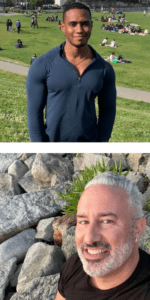Importance of Black-Centered Recovery Spaces at The Center
Close

 Throughout February, The Center has been celebrating Black History Month, where we are imagining what #BlackQueerJoy could look like. We take inspiration from the path-breaking impact of Center Dinner honorees like Michaela Jae Rodriguez and Roxane Gay; the far-reaching accomplishments of our RiseOut Advocacy Council members; and the (her)stories of Second Tuesday speakers such as Audre Lorde.
Throughout February, The Center has been celebrating Black History Month, where we are imagining what #BlackQueerJoy could look like. We take inspiration from the path-breaking impact of Center Dinner honorees like Michaela Jae Rodriguez and Roxane Gay; the far-reaching accomplishments of our RiseOut Advocacy Council members; and the (her)stories of Second Tuesday speakers such as Audre Lorde.
The Center was born of community activism in response to the AIDS epidemic in the early 1980s. Gay New Yorkers were committed to ensuring there was a place for LGBTQ+ people to access the information, care, and support that were unavailable anywhere else in the city. One of the ways The Center has cultivated a safe space is by creating closed support groups where our community members can gather and be free from mainstream stereotypes and marginalization. For our Black and people of color LGBTQ+ community members these groups are essential spaces where they can be their authentic selves without the judgment and scrutiny of racism and white supremacy—spaces where they can simply be.
We sat down with The Center’s Substance Use Treatment Counselor, Jeremy Simmons (he/him/his), and Senior Director of Behavioral Health, Antonio Ruberto Jr. (all pronouns welcome), to reflect on what it means to commemorate and celebrate Black history and the importance of closed affinity group spaces.
Antonio: I cannot emphasize enough the continued importance of highlighting and elevating Black History here in the United States. This is especially true in our current political climate, where people in positions of authority and power are trying to suppress these integral histories that have occurred in the U.S. these past 400+ years and beyond this country’s founding.
Jeremy: To me, Black History Month is a celebration of the immense pride in Blackness and our contributions to society. It means acknowledging the significance of all Black stories, even if our achievements aren’t etched in the history books. We are reminded that our existence has value, and the small ways we make a difference in the world do matter. So often, I am reminded of the ways we are oppressed, but this month, I feel there is a collective sharing of Black stories that uplift, unite, and make me feel good about my Blackness.
Antonio: A few years ago, a Black-identifed Center Care Recovery counselor pitched the idea for “In Living Color” during a team brainstorming session. She determined a need for a space within the program specifically for Black and people of color clients. The counselor worked with me and various Center departments to successfully create and launch the group. The importance of the group lies within the intersection of Queer and BIPOC identities and understanding the specific needs of community members within this intersection.
Jeremy: Historically addiction treatment programs are predominantly white, have a predominantly white clinical staff, and utilize treatment models that are not culturally responsive to the unique needs of BIPOC folks. “In Living Color” was started to carve out a space in which all Black and people of color feel seen and supported in their recovery from addiction AND racial oppression. Black LGBTQ+ folks need to have a safe space where they can let their hair down and be transparent about their feelings surrounding intersecting identities without worrying about being invalidated, which so often happens in white recovery spaces.
Jeremy: These spaces create a sense of connection and community where one feels celebrated, not simply tolerated. Spaces like “In Living Color” allow Black LGBTQ+ folks to embrace the unique ways in which our communities heal and prioritize wellness.
Antonio: Speak up! Elevate Black stories! Have difficult conversations with your fellow white or non-Black people of color friends, family members, and colleagues. Read and educate yourself. There are so many places to start. James Baldwin. Maya Angelou. bell hooks. Ibram X. Kendi.
Want to hear more, and even join in on this conversation yourself? Come to The Center! ‘In Living Color’ meets every Wednesday on a recurring basis from 1-2 p.m. As Jeremy and Antonio have demonstrated, we take a holistic, affirming approach in partnering with our community members to manage their substance use in closed support groups. To learn more, please visit our website or give us a call at 212.620.7310.